Transformation tables for administrative borders in Germany
The state has the ability to change the original spatial structure of its administrative regions. The stated goal of such a (municipal) territorial reform is usually an improvement in the performance of individual municipalities regarding planning, administrative and political matters. Since the German reunification in 1990, there have been a number of territorial reforms, especially in the New Federal States (Neue Bundesländer), through which municipalities and districts were merged or split up.
The tables provided here are meant to help users by facilitating work with longitudinal German regional data covering such territorial reforms and hence different territorial states.
A brief overview of the contents and structure of the available tables can be found here.
Access to the files
The IWH provides external researchers with these tables for statistical recalculation of districts and municipalities and the creation of temporally consistent territorial states for non-commercial research purposes only. The data is provided as downloadable Excel files. Access is granted upon application.
Please complete the application form with your personal data and a detailed research proposal, which documents your research interest. Based on this information we will conclude a user contract. Please note our terms of use.
We would like to point out that this free-of-charge offer is intended as assistance for scientists and was created with great care. However, we can not guarantee accuracy, correctness or up-to-dateness of the provided files (further information on the disclaimer of liability can be found in the imprint).
For further questions please contact: fdz@iwh-halle.de.
Publications
Kauffmann, A. (2015a): Wie lässt sich die Bevölkerungsentwicklung von Städten korrekt ermitteln? Eine Methode zur Bereinigung amtlicher Daten um die Effekte von Gebietsänderungen am Beispiel von Ostdeutschland. IWH-Online 5/2015: Leibniz-Institut für Wirtschaftsforschung Halle. LINK
Kauffmann, A. (2015b): Bevölkerungsentwicklung seit 1990 und weitere demographische Indikatoren von 132 ostdeutschen Städten in konstanten Grenzen von 2013. Abbildungsanhang zu IWH-Online 5/2015: Leibniz-Institut für Wirtschaftsforschung Halle. LINK
Kauffmann, A. (2017): Schlüsselbrücken und Matrizen zur statistischen Rückrechnung von Gebietsständen (Gebietsstands-Transformation) für Gemeinden und Kreise Deutschlands. LINK
Your contact
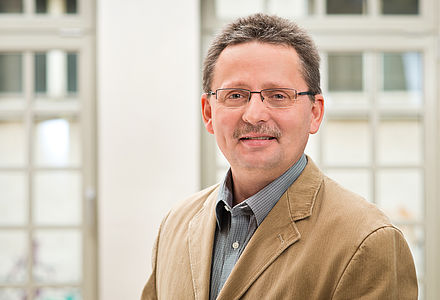
Research Data Centre
If you have any further questions please contact me.
+49 345 7753-758 Request per E-MailPublications

Foreword: Competing: Important Stimuli for Knowledge Cities to Become Prosperous
in: T. Yigitcanlar, K. Metaxiotis, J. Carrillo (eds), Building Prosperous Knowledge Cities. Policies, Plans and Metrics, 2012
Abstract
The author discusses the role of competitions in urban development strategies based on the cooperation of higher education institutions. The experience with similar strategies in regional policy and in innovation policy is reflected upon. After the presentation of some cases, the advantages and disadvantages of development strategies based on competitions are compared.
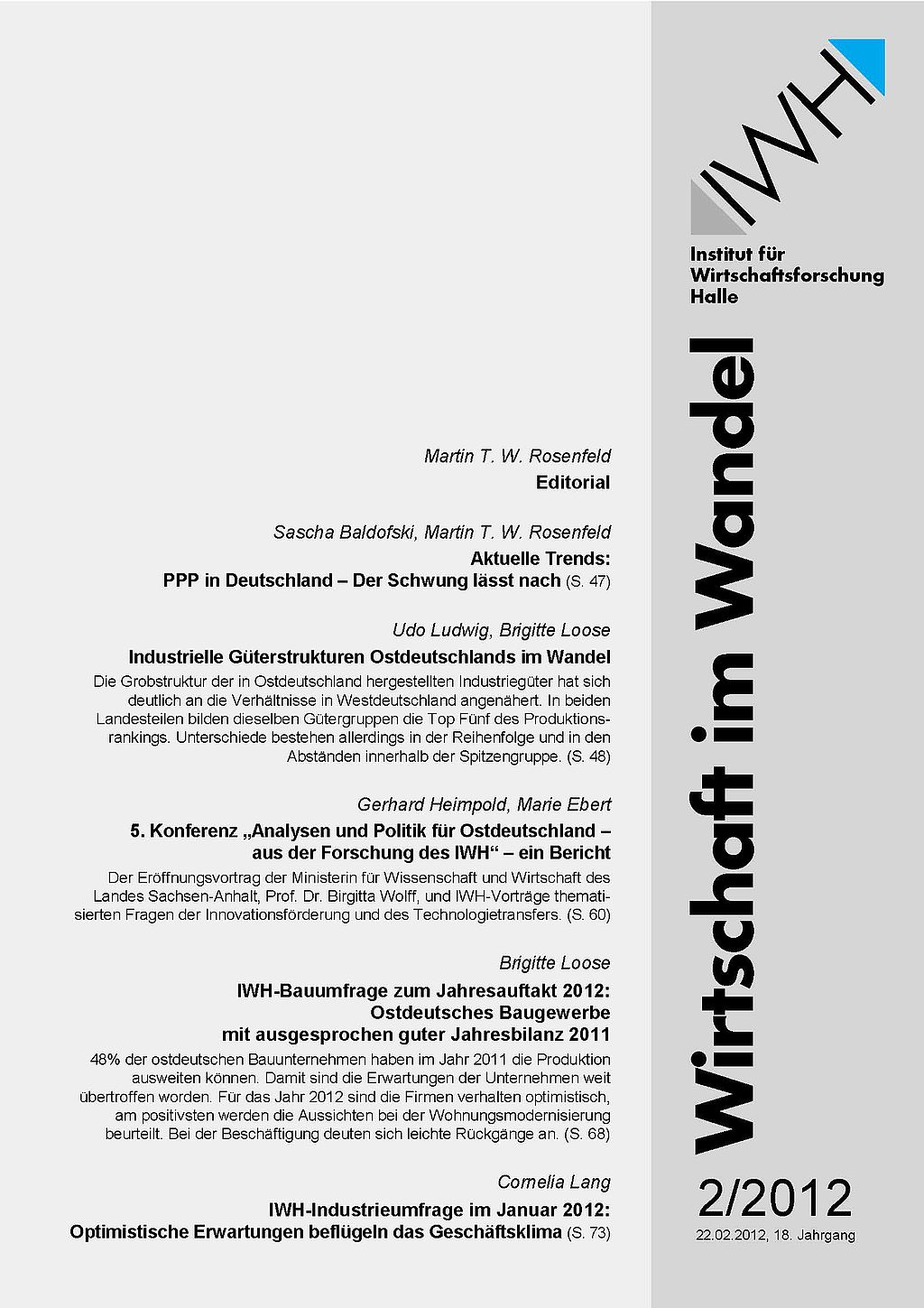
5. Konferenz „Analysen und Politik für Ostdeutschland – aus der Forschung des IWH“ – ein Bericht
in: Wirtschaft im Wandel, No. 2, 2012
Abstract
Der Beitrag berichtet über den Inhalt der Tagung „Analysen und Politik für Ostdeutschland – aus der Forschung des IWH“ am 21. September 2011, die – wie bereits die vier Vorgängerveranstaltungen seit 2007 – ein wirtschaftspolitisches Fachpublikum mit neuen Forschungsergebnissen des IWH vertraut machte. Im ersten Teil der Tagung lag, beginnend mit dem Eröffnungsvortrag der Ministerin für Wissenschaft und Wirtschaft des Landes Sachsen-Anhalt, Prof. Dr. Birgitta Wolff, der thematische Schwerpunkt bei Fragen der Innovationsförderung, des Technologietransfers und der Wissensflüsse. Diese Faktoren gelten – nicht nur in Ostdeutschland – als wichtig für die wirtschaftliche Konvergenz oder Divergenz von Regionen. Anschließend wurden auf der makroökonomischen Ebene Faktoren analysiert, die das Wirtschaftswachstum in Ostdeutschland beeinflussen. Es folgte ein Beitrag über die Effekte des Programms „Stadtumbau Ost“ für den Immobilienmarkt, bei dem Wirkungen von Abriss- und Aufwertungsmaßnahmen untersucht worden waren. Der abschließende Beitrag hatte die künftige Ausgestaltung der EU-Strukturpolitik zum Gegenstand, die bislang die wirtschaftliche Entwicklung in den Neuen Ländern massiv unterstützt hat.
Local Economic Structure and Sectoral Employment Growth in German Cities
in: Tijdschrift voor economische en sociale geografie, No. 5, 2011
Abstract
This study systematically examines the impact of fundamental elements of urban economic structure on sectoral employment growth in German cities (“urban growth”). We test four elements simultaneously – sectoral specialisation, diversification of economic activities, urban size and the impact of local competition. To account for the effect of varying spatial delimitations in the analysis of urban growth, we further differentiate between cities and planning regions as geographical units. Our regression results show a U-shaped relationship between localisation economies and urban growth and positive effects of local competition on urban growth. With respect to diversification, we find positive effects on urban growth on the city level, but insignificant results on the level of the planning regions. The impact of urban size also differs between free cities and planning regions; in the former, a U-shaped relationship is found, whereas the effect is inversely U-shaped for the latter.
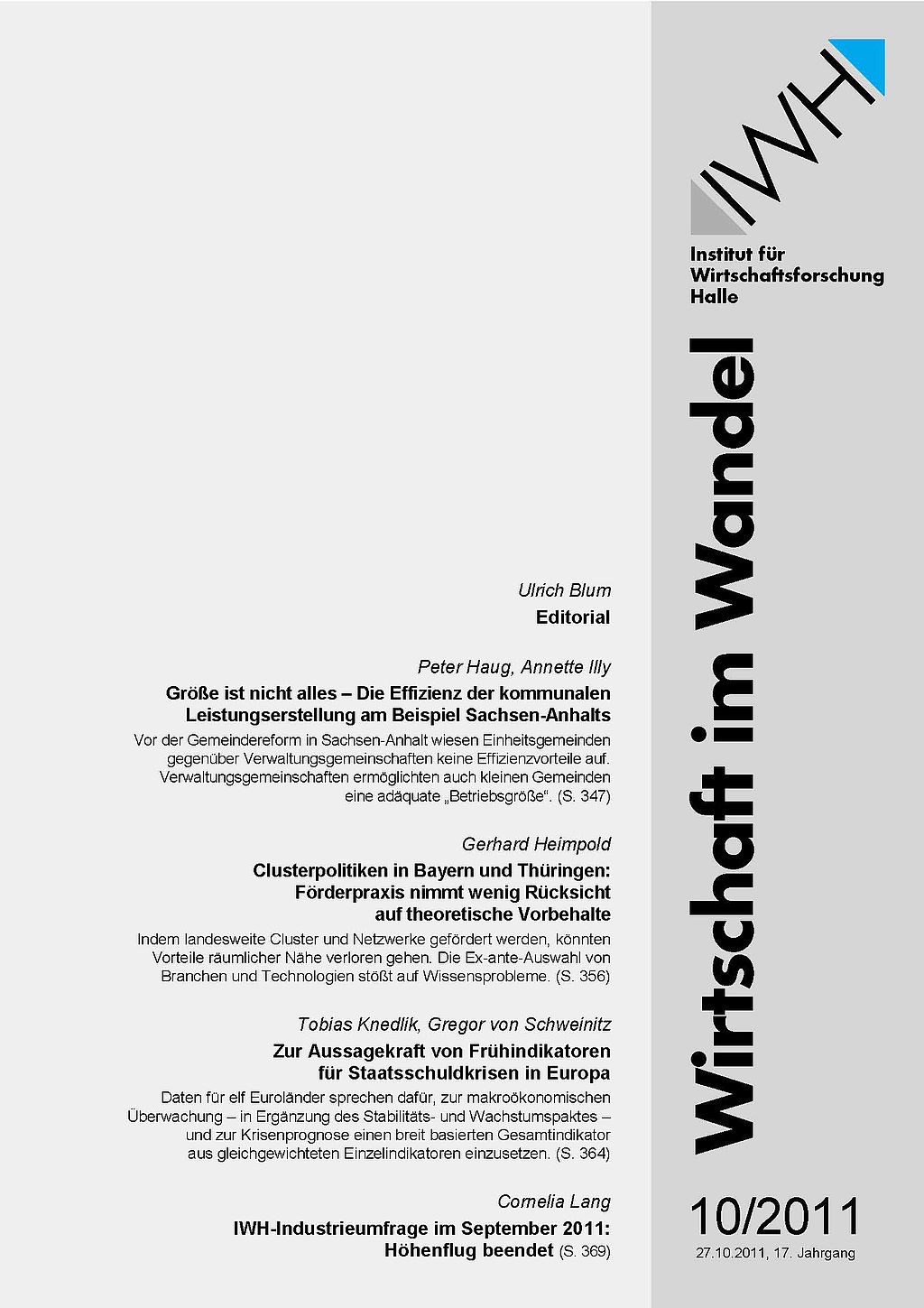
Size is not everything – The efficiency of municipal service provision in Saxony-Anhalt
in: Wirtschaft im Wandel, No. 10, 2011
Abstract
The proponents of municipal area reforms – e.g. the recently completed reform in Saxony-Anhalt – expect that municipal amalgamations or centralized organizational forms save costs or increase the efficiency of local public service provision. This article examines the potential efficiency deficits of Saxony-Anhalt´s fragmented municipal structures on the eve of the crucial phase of the municipal reform. The results of a two-step DEA bootstrap procedure show that decentralized municipalities (“Verwaltungsgemeinschaften”) do not have to be significantly less efficient than centralized municipalities (“Einheitsgemeinden”). Furthermore, the results of the scale efficiency analysis suggest that the majority of Saxony-Anhalt´s communities already had an approximately efficient “firm size” – if the aggregated level of the municipal associations is examined. The relationship between scale efficiency and population is U-shaped. On the one hand, the results do not support the preservation of micro-municipalities or the formation of municipal associations with more than ten members. On the other hand, the results provide also no evidence for the necessity to reduce the number of towns and municipalities in Saxony-Anhalt from 1118 in 2004 to currently 219 – even if the looming population decline is taken into account.

Stadtumbau – Preise – Investitionen. Empirische Untersuchungen zum Wohnungsmarkt auf Grundlage der Realoptionstheorie
in: Wirtschaftspolitik in Forschung und Praxis, Bd. 56. Zugl. Dissertation Martin-Luther-Universität Halle-Wittenberg, 2011
Abstract
Mit der Studie legt Dominik Weiß die erste umfassende Untersuchung vor, die sich quantitativ mit den Effekten des Stadtumbaus auf Preisbildung und Wertentwicklung am Immobilienmarkt auseinandersetzt. Durch die Anwendung eines realoptionstheoretischen Ansatzes wird eine innovative Analysemethodik angewendet, die zumindest in Deutschland bisher kaum mit umfangreichen empirischen Analysen verknüpft worden ist. Dadurch wird die Problematik der zeitlich verzögerten Wirkung baulicher Maßnahmen am Markt und der indirekte Charakter der Stadtumbauförderung für private Wohnungseigentümer adäquat berücksichtigt. Die Studie beleuchtet Entscheidungskalküle und das Investitionsverhalten von Hauseigentümern und liefert Erkenntnisse über die Potenziale und Grenzen der klassischen Stadtumbaumaßnahmen. Von besonderem Wert für Entscheider in Stadtentwicklung, Förderpolitik und Wohnungswirtschaft sind die umfangreiche Aufarbeitung ökonomischer Begründungen für die Stadtumbauförderung und die vielfältigen Hinweise und Empfehlungen zur Verbesserung und Weiterentwicklung des Stadtumbaus.
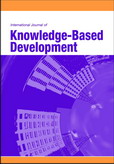
University Cities: Including Universities and Research Institutes into Strategies for Urban Growth
in: International Journal of Knowledge-Based Development, 2011
Abstract
The topic of this special issue refers to the observation that many larger and middle-sized cities dispose of a considerable potential of institutions creating and disseminating knowledge. This kind of endowment seems to be especially valuable in an upcoming knowledge-based economy. Recent strategic concepts and inter-city competitions referring to ‘knowledge-based urban development’, ‘knowledge city’, ‘creative city’, ‘science city’ or ‘entrepreneurial university’ indicate that urban planners and politicians are beginning to search for strategies to take advantage and to make use of this potential. The papers in this special issue a) present case studies of cities trying to activate their knowledge resources for local economic growth, b) deal with regulatory barriers and problems for cities applying ‘knowledge city’ strategies, c) analyze the university support for entrepreneurial activities, and d) discuss some implications of ‘knowledge city’ strategies for architecture and urban planning.
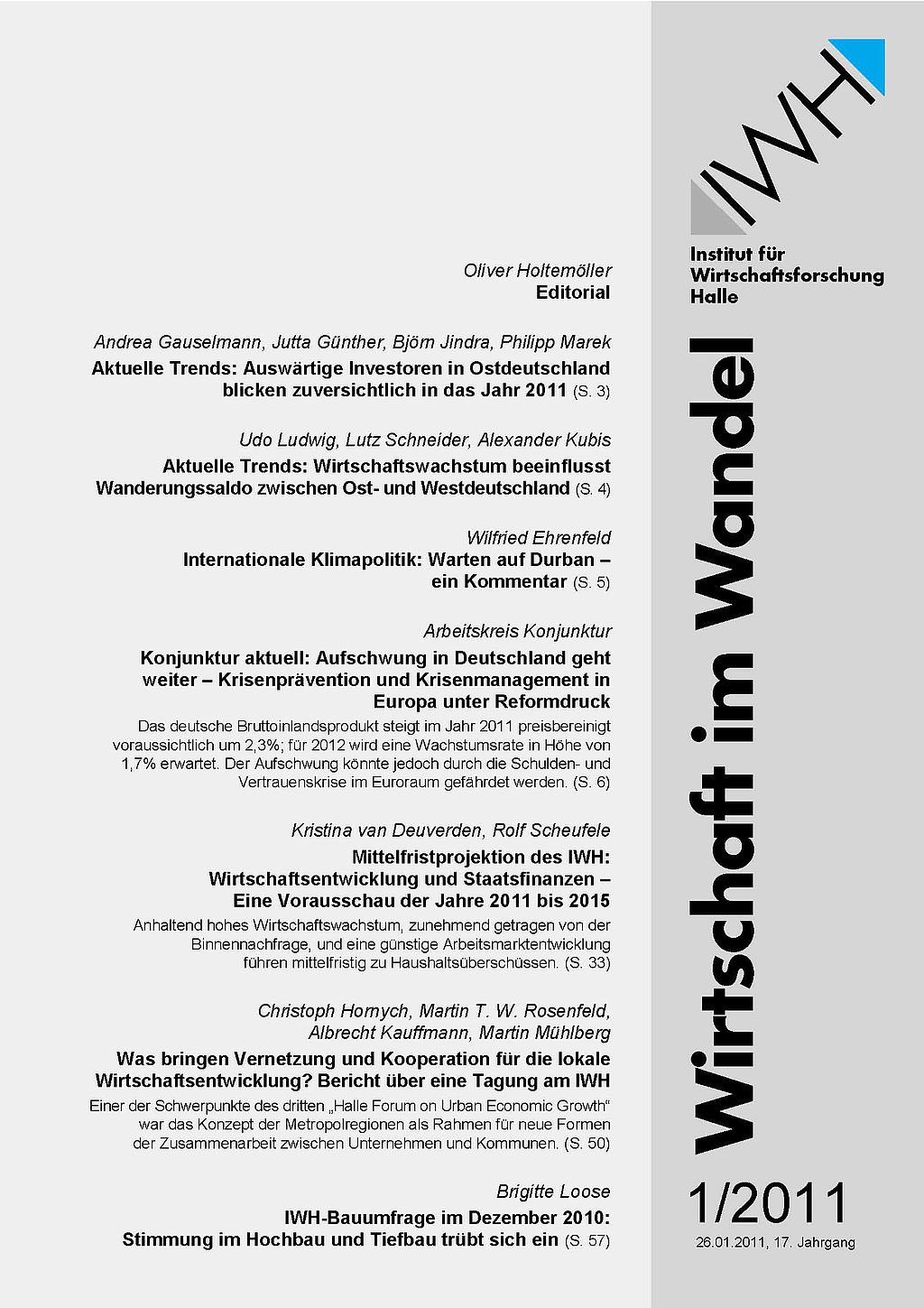
What are the benefits of cooperation and networking for the economic development of cities and metropolitan regions? Conference proceeding of the third “Halle Forum on Urban Economic Growth”
in: Wirtschaft im Wandel, No. 1, 2011
Abstract
The Department of Urban Economics of the Halle Institute for Economic Research (IWH) held on 2 and 3 December 2010 the third “Halle Forum on Urban Economic Growth“. The biennial “Halle Forum” focuses on the determinants of urban growth. This year's conference addressed the forms and benefits of cooperation and networking for the economic development of cities and metropolitan regions. The presentations and discussions focused on the one hand on the effects and determinants of inter-and intra-regional cooperation between firms, and on the other hand on cooperation between neighboring municipalities, especially through the establishment of metropolitan regions.
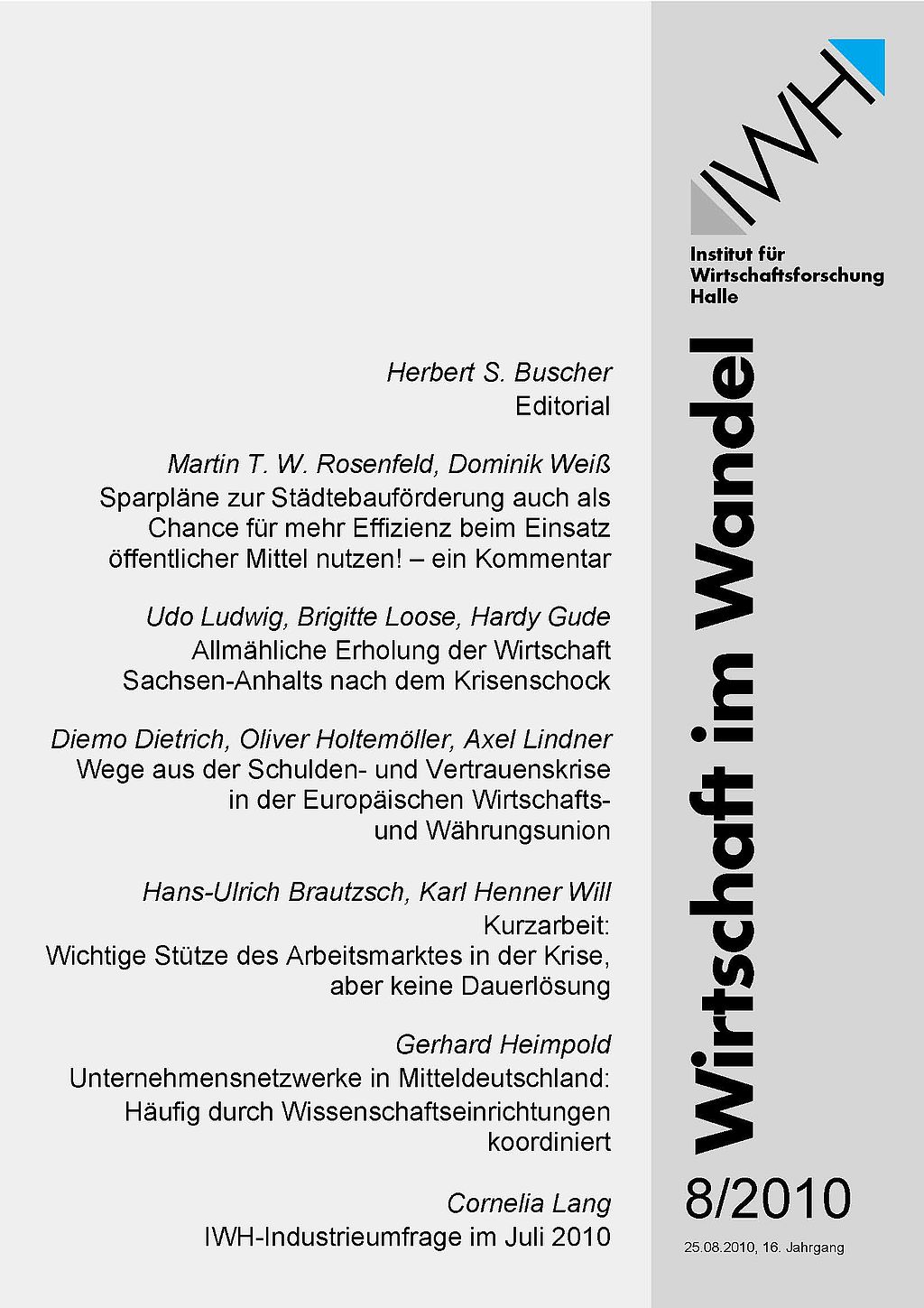
Sparpläne zur Städtebauförderung auch als Chance für mehr Effizienz beim Einsatz öffentlicher Mittel nutzen! – ein Kommentar
in: Wirtschaft im Wandel, No. 8, 2010
Abstract
Der Bund plant, im Jahr 2010 für Maßnahmen der Städtebauförderung insgesamt 535 Mio. Euro in rund 3 400 Stadtquartieren einzusetzen. Dies erfolgt im Rahmen des „klassischen“ Programms der „Stadtsanierung und -entwicklung“, zunehmend aber auch in Spezialprogrammen wie „Stadtumbau“, „Soziale Stadt“, „Aktive Stadt- und Ortsteilzentren“, „Städtebaulicher Denkmalschutz“ oder „Daseinsvorsorge im ländlichen Raum“. Im Rahmen des Sparpakets der Bundesregierung sollen die Städtebaumittel deutlich gekürzt werden. Diese Pläne haben in den vergangenen Monaten bereits zu einem Proteststurm der Städte sowie der Wohnungswirtschaft geführt, der sich in nächster Zeit – im Vorfeld der anstehenden Etatberatungen des Bundes – noch weiter verstärken dürfte. Einerseits ist dieser Protest verständlich. Jede Kürzung finanzieller Mittel wird bei den bisherigen Empfängern auf Ablehnung stoßen. Andererseits bieten die Sparabsichten auch die Chance, Schwerpunkte neu zu setzen und die Effizienz des Mitteleinsatzes zu erhöhen. Denn die Städte und ebenso der Bund müssen sich stets fragen lassen, ob die ihnen anvertrauten öffentlichen Mittel optimal verwendet werden. In manchen Fällen gibt es hieran berechtigte Zweifel.

Wer zahlt für das schöne Leben? Technische Infrastruktur in Zeiten von Bevölkerungsrückgang am Beispiel von drei ostdeutschen Mittelstädten
in: Tagungsband Arbeitskreis Stadterneuerung an deutschsprachigen Hochschulen, 2010
Abstract
In cities with decreasing population there is an increasing concern about the future cost of technical infrastructure. A diminishing number of inhabitants will have to bear the costs of the public services provided by their community. Beyond the pure cost arithmetic the main research question of our project was how urban planning can contribute to alleviating the rising average cost per service unit (cbm, sqm). The study was carried out for three medium-sized cities in the eastern part of Germany with a time horizon of 2030. The focus is on water, sewage and communal roads. The rather surprising result was that urban planning (attempts for densification, inner city development instead of extensivation of the urban fabric) has little effect on long-term cost compared to the unavoidable yearly renovation requirements of the technical infrastructure. Because of the dominant block of fixed cost in technical infrastructure systems, the demographic development is the main cost determinant. Therefore, in future a massive problem in financing today’s standard of public services will be imminent.
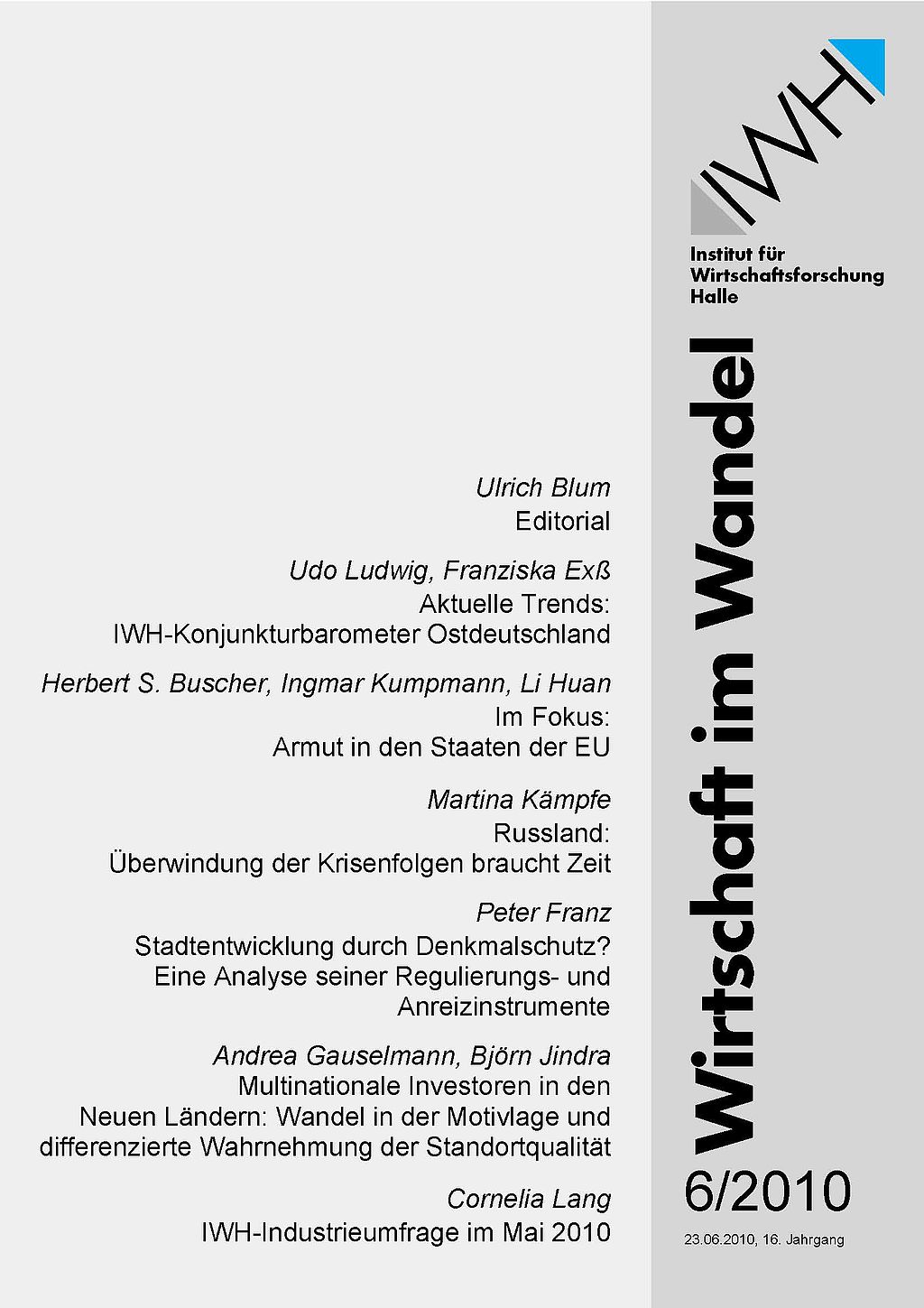
Urban Development by Protecting Historic Buildings? An Analysis of Incentives and Regulations in Heritage Conservation
in: Wirtschaft im Wandel, No. 6, 2010
Abstract
Regulations in heritage conservation play an important role in the redevelopment processes of East German cities. Numerous cities dispose of built cultural heritage still lending the cityscapes its character. As a reaction to the neglect of this cultural heritage during the GDR regime the East German Länder have enacted relatively restrictive heritage conservation laws. In addition to this the federal program “Städtebaulicher Denkmalschutz” was started in 1991 especially for the East German cities. In many cities activities for and investment in historic buildings have led to attractive urban centers. On the other side indicators become visible that an exaggerated heritage protection policy can turn out to be an obstacle for urban development. This paper takes an economic perspective on the topic of built heritage protection. In addition to this it contains a systematic overview over the policy arena, involving national and sub-national levels, actors and regulations. The financing of built heritage protection and recognizable intended and not intended effects of its measures are further topics of the paper. The results show that in East Germany a higher proportion of buildings is listed as in West Germany. The same is true when the public expenditures per head for heritage protection are compared. The analysis suffers from difficulties in assessing an optimal state of built heritage protection; a fact that signals further need in specific research.



